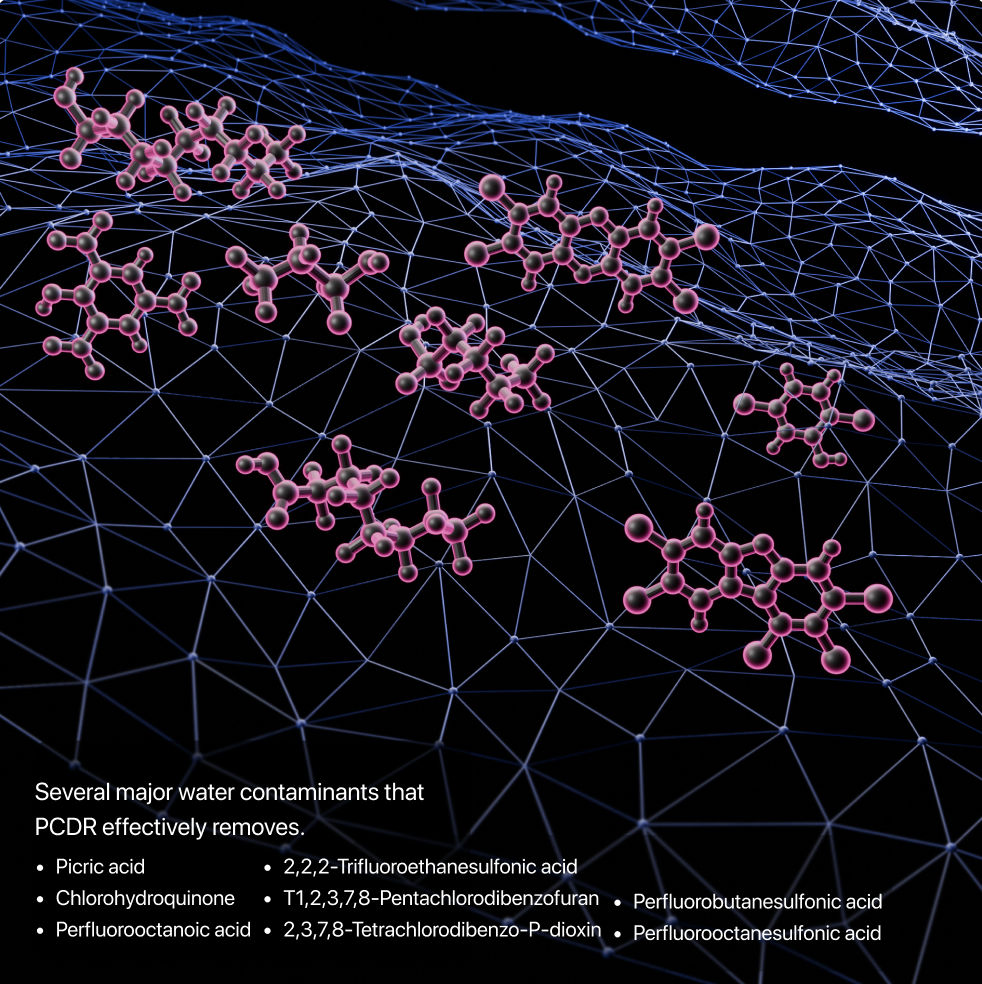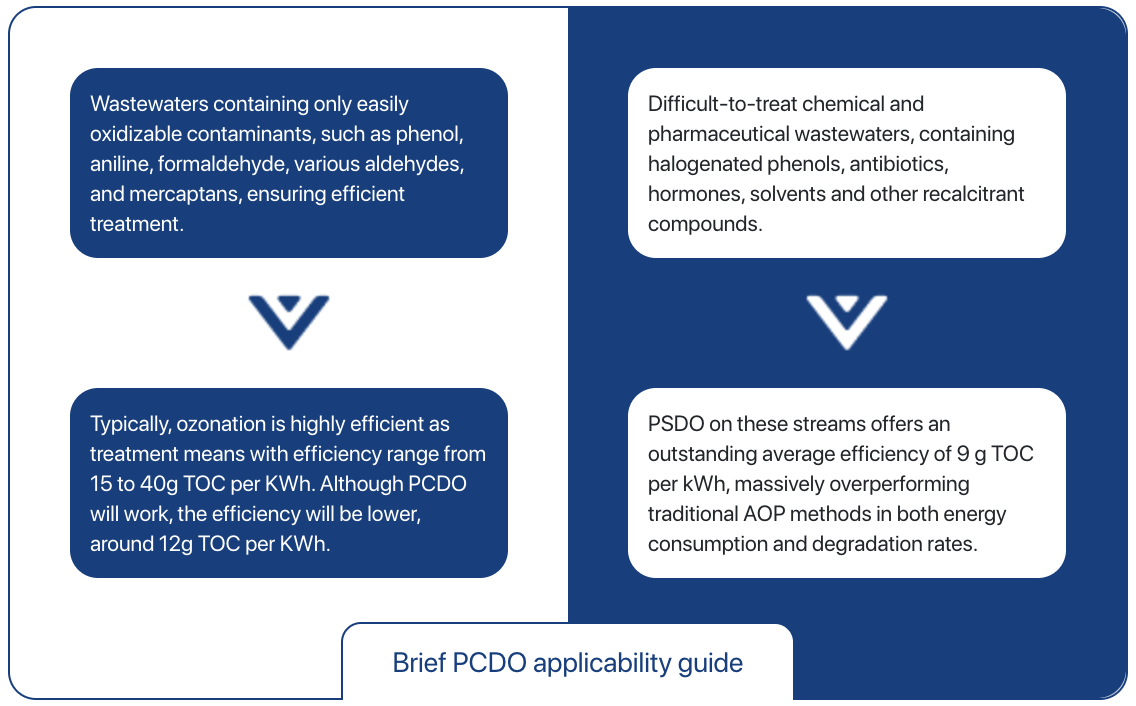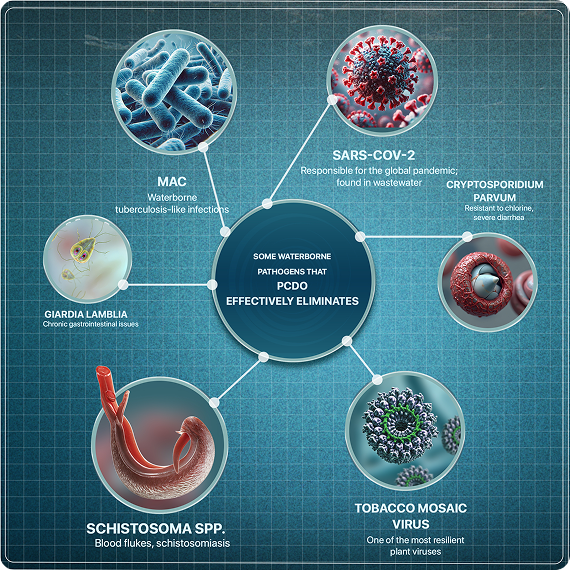Pulsed Corona Discharge Oxidation
(PCDO) Technology
Pulsed Corona Discharge Oxidation (PCDO) is a state-of-the-art water treatment process that utilizes high-energy pulsed corona discharges in oxidative atmospheres—typically in air or oxygen—to effectively degrade a broad spectrum of persistent organic and inorganic contaminants. By employing nanosecond pulse technology and optimized electrode configurations, PCDO creates a volumetric plasma region that interacts with water in unique ways, triggering robust oxidation reactions mostly driven by OH radicals. This innovative process not only degrades complex pollutants but also provides effective disinfection, making it an essential tool for advanced water treatment applications.
Operating Principles and Mechanisms
Pulsed Corona Discharge
in an Oxidative Atmosphere
- Oxidative Environment: PCDO operates in atmospheres enriched with air or oxygen, fostering the generation of highly reactive oxygen species (ROS).
Nanosecond Pulse Technology: Utilizing pulses on the order of nanoseconds, the system produces high-voltage corona discharges that initiate and sustain a powerful plasma while minimizing thermal effects. - Optimized Electrode Configuration: The discharge is established between two groups of electrodes, with at least one group made up of wire electrodes. This design promotes a volumetric corona discharge, ensuring extensive coverage of the reactive zone and enhancing overall efficiency.
- Water “Shower” Application: Water is introduced into the plasma region as a shower of large droplets, ensuring thorough exposure to reactive species.
- Alternate Dispersion Techniques: Options such as nozzle spraying, ultrasonic atomization, and electrostatic spraying are available to create finer droplets and enhance plasma contact, thereby optimizing oxidation efficiency for different applications.
Unique Behavior
in Nanosecond Fields
- Water as Insulator in Nanosecond Fields: While direct water injection might seem likely to cause a short circuit, the nanosecond pulse regime leverages the inertia of ions. During the brief pulse, ions in the water do not have enough time to move, causing even saline or low-pH water to act as an effective insulator.
- Stable Discharge Operation: This phenomenon ensures stable discharge, allowing the PCDO system to operate in a corona regime without sparks.
Voltage (kV) and current (A) oscillograms of a single impulse in a shower mode reactor for 1.2 mS cm-1 wastewater treatment.
Oxidation Mechanisms
and By-Products

Oxidation Mechanisms
and By-Products
- Primary Oxidation via OH Radicals: The dominant oxidation mechanism in PCDO is the generation of hydroxyl (OH) radicals.These radicals are produced through the dissociation of water vapor molecules within the discharge. With a high standard electrode potential (+2.8 V, second only to fluorine), OH radicals are among the most powerful oxidizers available, capable of breaking down a wide range of organic pollutants, including persistent and toxic substances.
- Role of Oxygen as a Scavenger:In the process, oxygen functions as a scavenger, reacting with free atomic hydrogen—also formed in the discharge—to shift the overall redox balance toward predominantly oxidative activity. This enhances treatment efficiency and accelerates pollutant degradation.
- Secondary Ozone Formation: Ozone is generated in modest amounts during the “wet” discharge; extensive research confirms that ozone-driven oxidation contributes only marginally to the overall treatment process.
- Low Selectivity Across Organic Contaminants: Due to the high oxidative potential of OH radicals, PCDO exhibits minimal differences in efficiency when oxidizing both easily and hard-to-oxidize organic compounds, making it a versatile solution for a wide range of applications.
Performance and Energy Efficiency
Comparative Advantages Over
Competing Technologies
- Electrochemical Oxidation: Electrochemical Oxidation and Wet Oxidation are effective at high contaminant concentrations (100 mg/L to grams per liter), but only achieve 96–99% removal. PCDO, in contrast, operates in the 0.1 to 100 mg/L range, achieving over 99.99% removal.
- Optimized for Post-Treatment: PCDO serves as an ideal post-treatment, providing deep mineralization and polishing after processes like electrochemical oxidation or wet oxidation.
Overall Efficiency and
Applicability
- Low Thermal Footprint: The nanosecond pulse approach minimizes heat generation, reducing unwanted by-products and keeping energy consumption low. For most applications, we operate without significantly altering the inlet water temperature. However, originally hot liquids can easily be treated: the system works effectively with hot streams, boiling water, and even challenging steam-liquid mixtures.
- Negligible Effect of Water Conductivity: Even with high salinity or extreme pH levels, the method’s efficiency remains stable due to low ionic conductivity in nanosecond fields, ensuring consistent performance in diverse conditions.
- Greater Efficiency for Tougher Contaminants: The PCDO method is ideal for treating challenging chemical and pharmaceutical wastewaters, including oil hydrocarbons, halogenated phenols, dyes, toxic and carcinogenic compounds, antibiotics, hormones, and endocrine disruptors, delivering superior treatment results.
- Tailored Dispersion Methods for Various Concentrations: We offer robust shower PCDO towers for low (0.1–10 mg/L) contaminant concentrations, while fine nozzles, ultrasonic, or electrospray methods are used for higher levels, providing flexible solutions for a wide range of treatment scenarios.
Measured Oxidation
Efficiencies
- For Easily Oxidizable Substances: When treating easily oxidizable compounds (using phenol as a standard), our PCDO implementation achieves an average efficiency of approximately 12 g TOC (total organic carbon) removed per kWh. Compared to oxidation with ozone and electrochemical oxidation, this is a modest efficiency, so we typically don’t recommend the single PCDO approach for streams congaing solely easy-to-oxidize pollutants, although it can be efficiently used for post-treatment to finally remove stable toxic pre-oxidation byproducts .
- For Hard-to-Oxidize Compounds: For more recalcitrant substances, such as 2,4,6-trichlorophenol, the system demonstrates an efficiency of around 9 g TOC per kWh. For these challenging pollutants, PCDO is highly effective comparing to conventional oxidation methods, making it suitable for treating a wide range of industrial and municipal wastewater.
- Superior Performance for Tough Contaminants: Although PCDO may be less effective than ozonation for easily oxidizable compounds, its energy efficiency for hard-to-oxidize substances outperforms conventional advanced oxidation processes (AOPs) like hydrogen peroxide or ozone with UV, catalytic ozonation, and similar methods by at least an order of magnitude. This makes PCDO an ideal choice for treating tough contaminants with lower operational costs.
Wastewaters containing only easily oxidizable contaminants, such as phenol, aniline, formaldehyde, various aldehydes, and mercaptans, ensuring efficient treatment.
Typically, ozonation is highly efficient as treatment means with efficiency range from 15 to 40g TOC per KWh. Although PCDO will work, the efficiency will be lower, around 12g TOC per KWh.
Difficult-to-treat chemical and pharmaceutical wastewaters, containing halogenated phenols, antibiotics, hormones, solvents and other recalcitrant compounds.
PSDO on these streams offers an outstanding average efficiency of 9 g TOC per kWh, massively overperforming traditional AOP methods in both energy consumption and degradation rates.
Brief PCDO applicability guide

Disinfection Capabilities

Broad-Spectrum Microbial
Inactivation
- Deep Disinfection: Beyond chemical oxidation, PCDO is highly effective in disinfecting water. The reactive species generated in the plasma not only oxidize organic and inorganic pollutants but also effectively inactivate bacteria, viruses, fungi, protozoa, and their spores.
- Low Energy for Disinfection: Achieving effective disinfection requires relatively low energy doses—typically not exceeding 0.15 kWh per cubic meter—ensuring that microbial decontamination is accomplished without significantly altering the water’s chemical composition.
Alternative for Pure
Disinfection Needs
- PCDS Technology for Minimal Chemical Change: In cases where disinfection is required without altering water chemistry, our PCDS technology is recommended. Based on corona discharges in a nitrogen atmosphere, PCDS offers excellent disinfection while preserving the water’s original chemical composition.
Key Benefits and Applications
High Oxidation and
Disinfection Efficiency
- Effective for a Broad Range of Contaminants: PCDO excels at oxidizing both organic and oxidizable inorganic impurities, including recalcitrant pollutants that are resistant to conventional treatments.
- Disinfection Power: In addition to oxidation, PCDO ensures deep disinfection, eliminating microbial pathogens to provide safe and clean water.
Energy Efficiency and
Cost-Effectiveness
- Optimized Energy Consumption: With low energy requirements for both oxidation and disinfection, PCDO offers a cost-effective solution for water treatment, reducing operational costs, improving efficiency, and supporting sustainable practices.
- Minimized Operational Complexity: The stable nanosecond pulse discharge minimizes maintenance and ensures long-term reliability, making PCDO a dependable choice for continuous operation in various settings.
Flexible and Scalable
Water Treatment
- Adaptability to Various Water Matrices: Whether dealing with municipal wastewater, industrial effluents, or natural water bodies, PCDO is designed to adapt to diverse water qualities and contaminant loads.
- Scalable Solutions: Our systems can be tailored for small-scale applications or integrated into large municipal or industrial water treatment plants.
Turnkey Integration and
Custom Design
- Comprehensive System Design: We specialize in designing turnkey water treatment systems that integrate PCDO with complementary technologies. This enables a holistic approach to addressing water contamination challenges—from high-concentration pre-treatment to final polishing.
- Customizable to Client Needs: Our engineering team works closely with clients to develop tailored solutions that optimize performance and seamlessly integrate with existing infrastructure.
Applications
PCDO technology is versatile and finds use in a wide range of water treatment and
remediation scenarios:
Tough Wastewater Treatment:
Chemical and Pharmaceutical Industries: Degrade complex organic compounds and recalcitrant pollutants, ensuring compliance with strict discharge standards.
High-Salinity and Low pH Streams: Treat challenging wastewaters effectively using the transient insulation effect during nanosecond pulses.
Tough Wastewater Treatment:
Chemical and Pharmaceutical Industries: Degrade complex organic compounds and recalcitrant pollutants, ensuring compliance with strict discharge standards.
High-Salinity and Low pH Streams: Treat challenging wastewaters effectively using the transient insulation effect during nanosecond pulses.
Municipal Water Purification:
Trace Contaminant Removal: Achieve deep oxidation of trace pollutants to produce water that meets or exceeds regulatory standards.
Post-Treatment Polishing: Serve as an ideal post-treatment method following upstream electrochemical, biological or advanced oxidation processes.
Municipal Water Purification:
Trace Contaminant Removal: Achieve deep oxidation of trace pollutants to produce water that meets or exceeds regulatory standards.
Post-Treatment Polishing: Serve as an ideal post-treatment method following upstream electrochemical, biological or advanced oxidation processes.
Environmental Remediation:
Site Cleanup and Restoration: Address polluted water bodies and contaminated aquifers, reducing the environmental impact of hazardous substances.
Emergency Response: Provide rapid remediation in cases of environmental spills or disasters, restoring safe water conditions quickly.
Environmental Remediation:
Site Cleanup and Restoration: Address polluted water bodies and contaminated aquifers, reducing the environmental impact of hazardous substances.
Emergency Response: Provide rapid remediation in cases of environmental spills or disasters, restoring safe water conditions quickly.
Combined Treatment Systems:
Integration with Other: Seamlessly integrate with ion-exchange preconcentration (e.g., GLOIO) or advanced oxidation processes to tackle the most challenging water treatment scenarios, improving system efficiency, lowering operational costs, and ensuring compliance with strict environmental standards.
Combined Treatment Systems:
Integration with Other: Seamlessly integrate with ion-exchange preconcentration (e.g., GLOIO) or advanced oxidation processes to tackle the most challenging water treatment scenarios, improving system efficiency, lowering operational costs, and ensuring compliance with strict environmental standards.
Conclusion
- Pulsed Corona Discharge Oxidation (PCDO) is a groundbreaking technology that delivers robust oxidation and disinfection through the use of pulsed corona discharges in an oxidative atmosphere. Its primary mechanism, based on the formation of highly reactive OH radicals from water vapor dissociation, ensures uniform and deep oxidation of both easily and hard-to-oxidize contaminants. With its exceptional energy efficiency, low thermal footprint, and versatile water dispersion techniques, PCDO outperforms many traditional advanced oxidation processes, particularly for treating contaminants in the 0.1 to 100 mg/L concentration range. This technology is highly adaptable to various industrial applications, including chemical manufacturing, pharmaceuticals, and wastewater treatment plants, where stringent discharge standards demand highly effective and reliable treatment solutions. Additionally, PCDO systems can be seamlessly integrated with other water treatment technologies, enhancing overall system performance, reducing operational costs, and providing scalable solutions for both small- and large-scale treatment facilities.
- In addition to its oxidation capabilities, PCDO provides thorough disinfection—effectively neutralizing a wide range of microbial pathogens at low energy doses. For applications where disinfection is the sole requirement without altering water chemistry, our PCDS technology offers an ideal alternative.
- Our turnkey project design services ensure that each water treatment system is custom-engineered to meet your specific needs, integrating PCDO seamlessly with complementary technologies for optimal performance. Whether you are addressing industrial effluents, municipal water treatment, or environmental remediation, PCDO represents a powerful, energy-efficient, and highly reliable solution.
- Explore how Pulsed Corona Discharge Oxidation can transform your water treatment operations. Contact us today to learn more about our advanced oxidation solutions and comprehensive turnkey project design services.
